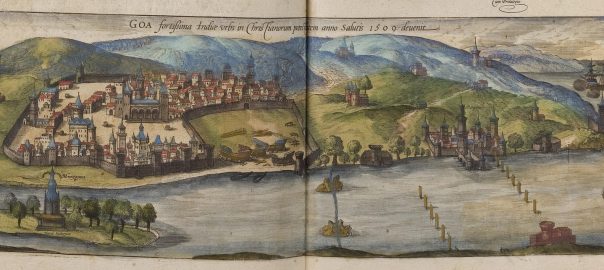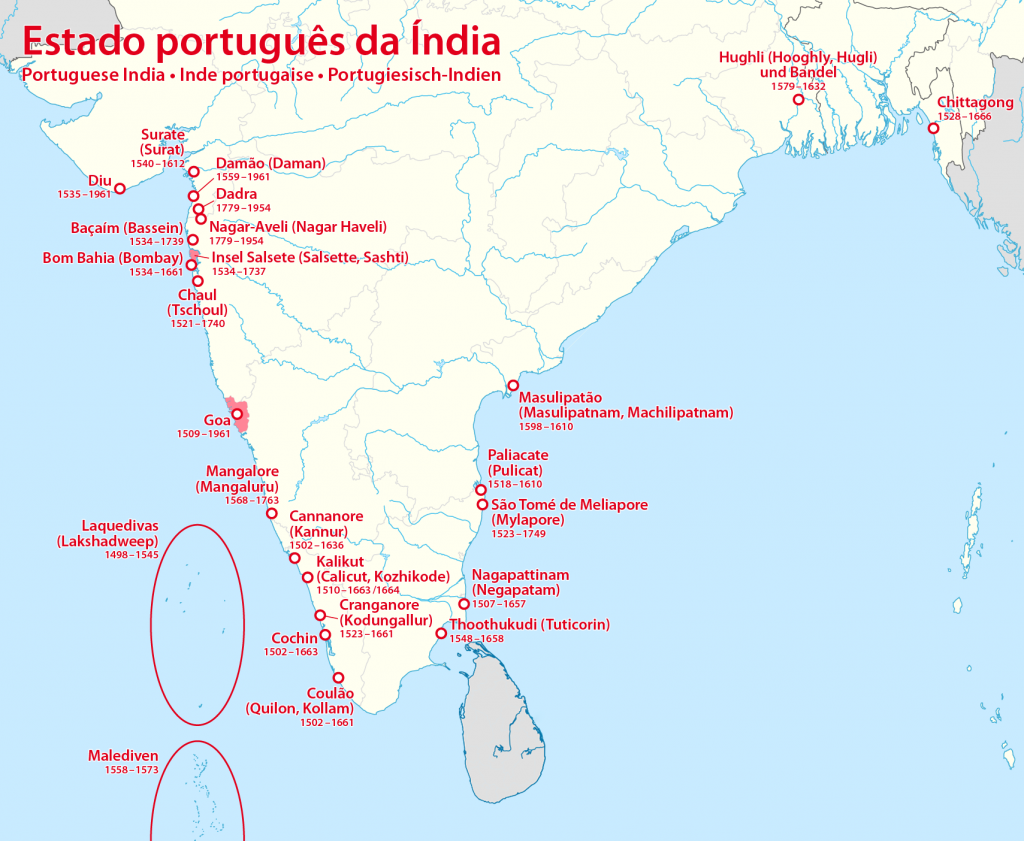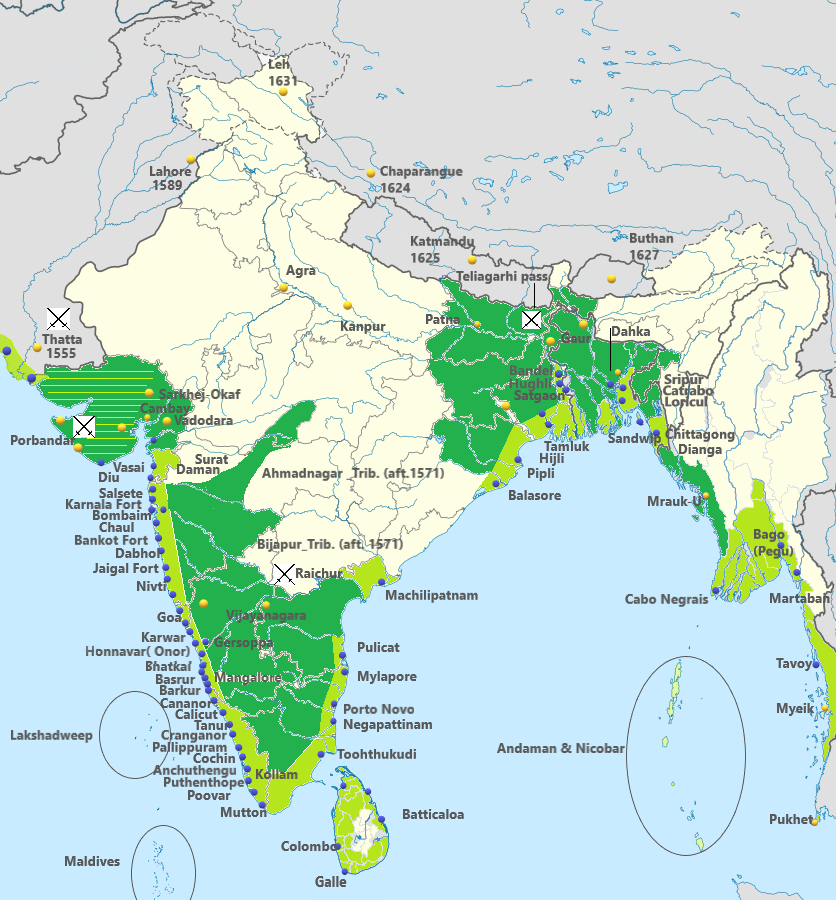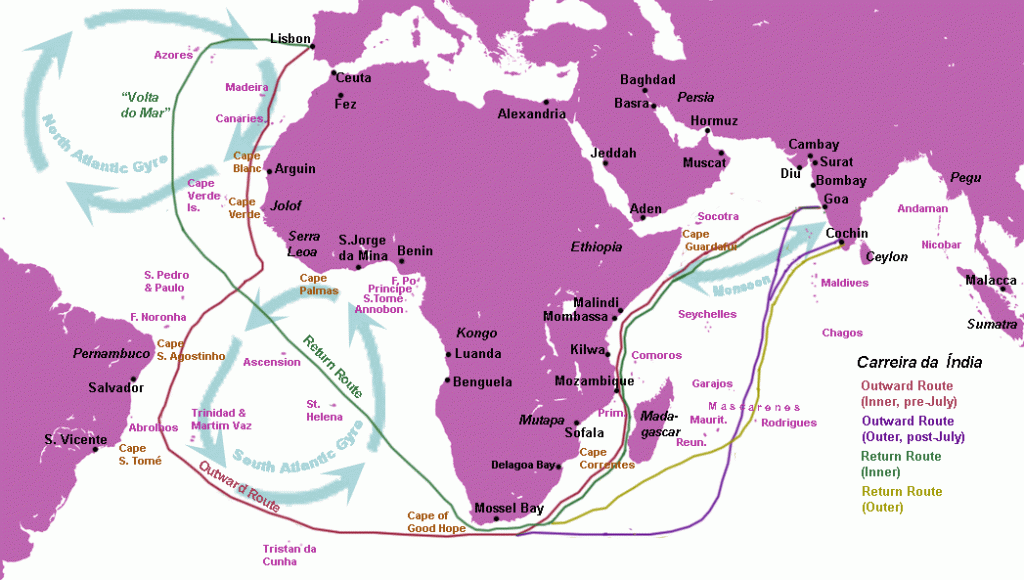England, I know, is waiting impatiently in the wings before truly making a big debut onto the “stage” of global empire-building. In 1583 CE, 44-year-old Humphrey Gilbert (the anti-Irish sadist whom we’ve met before) set out with five ships to go out and “claim” Newfoundland for Queen Elizabeth. His crews were “made up of misfits, criminals and pirates, but in spite of the many problems caused by their lawlessness, the fleet reached Newfoundland.” There, he turned a spadeful of sod in a ritual act of land-claiming. He died on the trip back home. But that did not prevent Elizabeth from launching further empire-building projects at an accelerating pace over the years to come…
But this year’s two major stories of world-historical importance concerned Portugal. The first was the definitive end of Portugal’s succession crisis, when a Spanish fleet of 28 warships finally defeated the anti-Spanish claimant to the Portuguese throne (António, Prior of Crato) in the Azores, where he had the support of a French fleet of 60 warships, which was not enough to save him. (Elizabeth, remember, decided to sit this one out rather than helping António.)
For more than half a century to follow, the Spanish and Portuguese monarchies would collaborate in the governance of the new “Iberian Union”– along with all its many imperial holdings around the world. More details of how this collaboration was organized were given here. Bottom line: Spain and Portugal each continued to run their own separate empires on parallel tracks, but with some new collaboration.
But now, the main focus of today’s post:
A look at Portuguese India

Back in 1510, a Portuguese commander called Afonso de Albuquerque had attacked and captured Goa, on the west coast of India, with a force made up of “23 ships, 1,200 Portuguese soldiers, 400 Portuguese sailors, 220 Malabarese auxiliaries from Cochin, and 3,000 ‘combat slaves’ (escravos de peleja).” He did not take the city easily, but by the end of the year he was in control of it. Goa became an important center of trade for the Portuguese in the Indian Ocean; and in 1530 it became the capital of the whole of the “Portuguese State of India”, a body that for centuries to come would supervise Portuguese affairs all around the coast of India and bordering the whole Indian Ocean from Mozambique to Timor.
(The banner image above is a general view of Goa from the sea, 1509.)
But in 1583, he Portuguese in Goa met a serious challenge to their rule from residents of what is described as a “border village”, Cuncolim, located south of the city.
By now, the Portuguese in Goa were no long content, as they had been back in Albuquerque’s time, to let the Indian indigenes continue with their traditional religions and folkways. In 1536, the Portuguese monarch had established his own Inquisition, parallel to the one run by Spain; and in 1560 it set up its own special branch in Goa, the Goa Inquisition, whose task was “to enforce Catholic orthodoxy in the Indian colonies of the Portuguese Empire.” Its main targets were both the “New Christians”– recent converts from Hinduism or Islam– and members of the ancient, pre-existing Nestorian Christian churches in the area that had been established in the first century CE. The Jesuits and their co-founder Francis Xavier, were very important in this venture.
Actually, English-WP tells us this: “A Portuguese order to destroy Hindu temples along with the seizure of Hindu temple properties and their transfer to the Catholic missionaries is dated 30 June 1541.”
You get the picture… The people of Cuncolim, living just on the borders of Portuguese rule in Goa, had numerous rich and busy Hindu temples that were magnets for frequent festivals and pilgrimages and pretty central to the village’s economy. So in July 1583, along come a group of five Jesuits accompanied by one Portuguese layperson and 14 native converts “with the objective of erecting a cross and selecting ground for building a church.” It did not go well. All were slaughtered by the enraged locals.
Then this:
As retribution, the Portuguese army raided and destroyed orchards and feilds surrounding the village. The Kshatriya chieftains of Cuncolim were then summoned for talks at the Assolna fort… Charged with the act of treachery, sixteen of them were summarily sentenced to death without trial by the Portuguese authorities…
Following the execution of their leaders, the villagers of Cuncolim, Velim, Assolna, Ambelim and Veroda refused to pay taxes on the produce generated from their fields and orchards to the Portuguese government. As a result, their lands were confiscated and entrusted to the Condado of the Marquis of Fronteira… Most of Cuncolim’s population converted to Christianity, in the years following the massacre. The Church of Nossa Senhora de Saude was constructed by the Portuguese at the site of the massacre.
Afterwards, the five slain Jesuits were “beatified” by the church– but not their equally dead native informants. One of the slain Jesuits had been in the mission that had spend three years in the court of Mughal Emperor Akbar. When Akbar heard of his death he is reported to have said, “”Alas, father, my advice was good that you should not go, but you would not follow it.”
Learning about these latter events caused me to go and research more about the Portuguese in India; and what I learned caused me to revise, considerably, my previous view of the Portuguese in the Indian Ocean having interacted with the indigenes whom they encountered in a fairly respectful way based on strong shared interests in trade and profits… Maybe in many cases, the encounters had started out that way, back at the beginning of the century when Portuguese ships started sailing in significant numbers to, and around the shores of, the Indian Ocean.
But those ships were always armed. Vasco da Gama had “discovered” the sea route to the Indian Ocean in 1497-99; and from 1500 on, Portugal’s royally chartered “Casa da Índia” in Lisbon would organize an annual Carreira da Índia (“India Run”), a fleet of armed ships that would set out from there and, skilfully using the prevailing winds, would hope to make it around the Cape of Good Hope and over to India, and back, within a year. This amazing page on English-WP provides numerous details about the organization of these fleets:
In the first decade (1500–1510), when the Portuguese were establishing themselves in India, the armadas averaged around 15 ships per year. This declined to around 10 ships in 1510–1525. From 1526 to the 1540s, the armadas declined further to 7-8 ships per year — with a few exceptional cases of large armadas… brought about by military exigency, but also several years of exceptionally small fleets. In the second half of the 16th century, the Portuguese Indian armada stabilized at 5-6 ships annually, with very few exceptions…
Organization was principally in the hands of the Casa da Índia…The Casa was in charge of monitoring the crown monopoly on India trade – receiving goods, collecting duties, assembling, maintaining and scheduling the fleets, contracting private merchants, correspondence with the feitorias (overseas factories [but more like warehouses]), drafting documents and handling legal matters.
Separately from the Casa, but working in coordination with it, was the Armazém das Índias, the royal agency in charge of nautical outfitting, that oversaw the Lisbon docks and naval arsenal… The piloto-mor (‘chief pilot’) of the Armazém, in charge of pilot-training, was, up until 1548, also the keeper of the Padrão Real, the secret royal master map, incorporating all the cartographic details reported by Portuguese captains and explorers, and upon which all official nautical charts were based.
Ships could be and sometimes were owned and outfitted by private merchants, and these were incorporated into the India armada. However, the expenses of outfitting a ship were immense, and few native Portuguese merchants had the wherewithal to finance one, despite eager government encouragement. In the early India runs, there are several ships organized by private consortiums, often with foreign capital provided by wealthy Italian and German trading houses. This fluctuated over time… Marine insurance was still underdeveloped, although the Portuguese had helped pioneer its development and its practice seemed already customary.
And this aspect of the venture was important, too:
Naval artillery was the single greatest advantage the Portuguese held over their rivals in the Indian Ocean – indeed over most other navies – and the Portuguese crown spared no expense in procuring and producing the best naval guns European technology permitted.
King John II of Portugal, while still a prince in 1474, is often credited for pioneering the introduction of a reinforced deck on the old Henry-era caravel to allow the mounting of heavy guns. In 1489, he introduced the first standardized teams of trained naval gunners (bombardeiros) on every ship, and development of naval tactics that maximized broadside cannonades rather than the rush-and-grapple of Medieval galleys.
The Portuguese crown appropriated the best cannon technology available in Europe, particularly the new, more durable and far more accurate bronze cannon developed in Central Europe, replacing the older, less accurate wrought-iron cannon. By 1500, Portugal was importing vast volumes of copper and cannon from northern Europe, and had established itself as the leading producer of advanced naval artillery in its own right…
It now seems clearer to me that the intention of the Portuguese navigators and their succession of royal backers had always been– or early in the 16th century, soon became– not just to join the vibrant pattern of (generally Muslim-dominated) sea-borne trade around the Indian Ocean, but to disrupt it.
And then, once you have an active “Goa Inquisition”, this disruption becomes an imperative. After all, the Portuguese were now disrupting the well-established trading patterns previously maintained around the Indian Ocean’s shores by Muslims, Hindus, Nestorians, and Jews– and doing so, in the name of God.
(Oh, and it was also profitable.)





